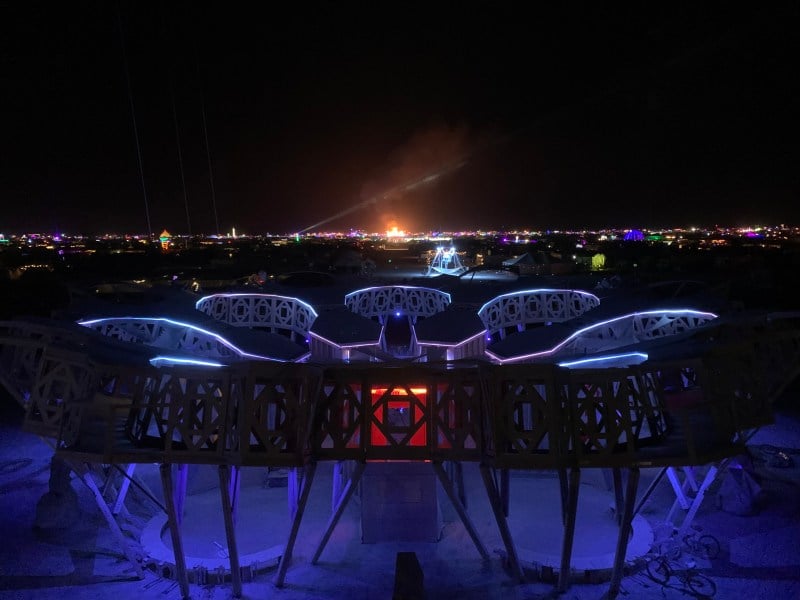After three years of COVID-related delays and cancellations, the week-long Burning Man festival finally returned to Nevada’s Black Rock Desert. Over 70,000 participants, known commonly as “Burners,” gathered in the desert to appreciate the festival’s large-scale art, ranging from interactive sculptures to adjective performances. Aspiring and seasoned artists all sought to follow this year’s theme: “Waking Dreams.”
One of these art installations was “Catharsis,” a massive fractal gallery and amphitheater. The ambisonic sound exhibition within Catharsis, titled “Antimatter,” was led by Angela Lee M.S. ’23, a graduate student at Stanford’s Center for Computer Research in Music and Acoustics (CCRMA).
Deriving inspiration from John Koenig’s “The Dictionary of Obscure Sorrows,” “Antimatter,” is defined as the “dream version of things in your life.” The project utilized ambisonic audio to create an audial dimension in the “Catharsis” amphitheater, enhancing the experience through soundscapes, ranging from music to spoken word to specific sound creations.
Unlike other audio formats, ambisonics allow artists to create a 3-dimensional sphere of sound, where sounds can travel above, below and around the listener. Because the Catharsis amphitheater has a seven-fold symmetrical structure, the “Antimatter” team had to build a custom system to continue that symmetry while integrating the ambisonic sound with the rest of the construction thereby “pushing the boundaries of sound.”
“I saw Burning Man as an opportunity to explore what it is that I value the most in a potential career,” Lee said. “Here at CCRMA, the community is small, like our network is pretty small in the performances we get. I wanted to explore [ambisonic audio] more on a larger scale, to bring in a diversity of compositions, to see what’s out there besides experimental noise music and to see what potential ambisonics could have for other genres. I think giving people the opportunity to take advantage of this space in the desert, in this very specific event, is pretty special to me.”
However, the challenge of working with a new sound format paled in comparison to the challenge of the build, as well as adapting to any last-minute changes to the amphitheater. Not only was the “Antimatter” team fighting the natural elements of the desert, but they were also limited to using only the materials that they brought in advance, leaving little room for error. Furthermore, operating under Burning Man’s “leave no trace” philosophy meant that the team had to develop strategies to contain all of their materials, including processes to prevent sawdust from blowing away in the 15 mph winds of the desert.
“It’s a lot like camping in the hardest camping spot you’ve ever been to, but at the same time you have to work 14-hour days building. And everyone else around you is fighting the same struggle of elements and trying to put in the work that is required to make a monumental project like this happen,” said Dirk Roosenburg M.S. ’23, the technical lead of the exhibit. “I’ve been tangentially part of large art before, but this project has definitely introduced a ton of responsibility into my life that I did not expect or anticipate, but have enjoyed learning from.”
Despite the challenges, “Antimatter” was completed in time for the start of Burning Man, showing the Burners how sound elements affect physical spaces in what they feel like, how they function and how people interact with them.
“It was really beautiful to see,” said Samantha Sethna, the third core member of the “Antimatter” team. “People were drawn into this space by soundscapes in a subtle way, where people weren’t actively super aware of the sound installation. It was more ambient and like something you don’t notice, but it is definitely coloring your experience. It very apparently guided people throughout the space and invited them in. Once they were in, it gently directed them in a way where people could stop and slow down, which out there is rare. I saw a lot of curiosity in people, a lot of people finding refuge from the greater context of Burning Man.”
Burning Man is known for its principle of “radical self-expression,” which it seeks to implement through collective art and decommodification, drawing artists and creative minds from all over the world who wish to join.
“Making art in the real world is very hard and not a lot of people make space for it in their lives,” Roosenburg said. “As a part of this project and a part of Burning Man, I’ve met a ton of people that have made space in their lives to make big, crazy, insane art happen on a scale that I’ve never seen before.”
Editor’s Note: This article is a review and includes subjective thoughts, opinions and critiques.
